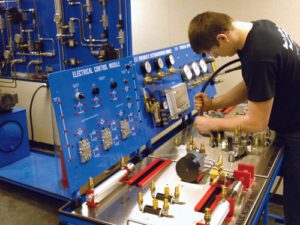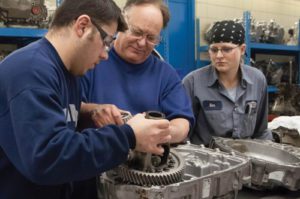
Alex Violassi has one message for Michigan workers: “Manufacturing is cool,” he says, standing in front of a 3D printer in his office. “It’s not the dingy, oily place it once was. It’s amazing.”
The machine, no bigger than a standard inkjet printer, can print almost anything with a 3D model including toys, machine parts and hair combs.
As director of Automation Alley’s new Product Lifecycle Management (PLM) Center at Oakland University, part of Violassi’s job is to promote the new face of manufacturing.

PLM – a process of digitally managing the performance of a product throughout its entire lifecycles – uses data and virtual models to remove a lot of the dirty work. It’s the wave of the future not just for giant manufacturers but for production on any scale, he says.
“Tier 1 companies get it because they are forced to. We have to force technology down the tiers,” Violassi says. “A lot of these small businesses, they don’t know what’s coming.”
PLM is essential in building a product with a virtual 3D model. Today, many smaller companies still are putting 2D design prints on the plant floor, which needs to change, Violassi says.
In the manufacturing phase of PLM, it’s all about “bits before atoms,” according to Michael Grieves, a PLM expert and author of the book “Product Lifecycle Management: Driving the Next Generation of Lean Thinking.”
That means you can test a tool or product before buying any of the parts and correct failure at a fraction of the cost, Grieves says.
For instance, General Motors Corp. now uses 3D models for virtual crash-test simulations, saving $350,000 for each physical crash test it replaced. If a competitor were still using 2D design sheets, they would be in the dust.
Of course, none of this could happen without the right people. And by now it’s no secret: As more companies of all sizes and industries are embracing technology driven models, more technology workers are in demand.
To help measure Michigan’s tech rebound, a recent report from Automation Alley, Michigan’s largest technology business association, shows the state gained 31,536 technology-related jobs from 2010 to 2011.
That’s still down nearly 70,000 jobs from pre-recession days, but Metro Detroit is second only to Chicago for Midwest technology job growth, putting the region on a path to regain and surpass its former highs, the report states.
In the meantime, experts say it’s crucial that everyone – not just academics and industry leaders – understand the nuances of the employment shift that is taking place.
Despite the state’s diversifying economy, the automotive industry is still the single most driving economic force in Michigan. And that’s not a bad thing according to economist Jim Jacobs, president of Macomb Community College.
Back in 2005 when Automation Alley published its first annual Technology Industry Report, a key finding identified the automotive industry as a major part of Michigan’s tech industry. In fact, auto-related jobs make up more than 40 percent of the tech jobs in the Metro Detroit area, according to the most recent report.
“Given the convergence of smart vehicles and the use of IT and big data, (the Big Three) are now looking to compete for the kinds of people who go to Google or Microsoft,” Jacobs, says. “It’s a new ball game but the same industry.”
One example of this comes from GM. The automaker is spending nearly $400 million on two new technology centers in Michigan. One is already up and running in Warren; another larger one is slated to open in Milford this summer.
“Today, every single link of the automotive value chain is wired and connected from design to the showroom floor,” former GM Chairman and CEO Dan Akerson said at a press conference last year. “That’s why for any company, not just an automotive manufacturer, to be successful in the 21st century you have to have a core competency in IT.”
From its digital Command Center in Warren, workers can monitor and control IT functions at all 121 GM plants worldwide in addition to IT products and services supplied to more than 17,000 GM dealers.
The idea that Michigan is moving to an entirely new economy is a bit of a myth, Jacobs said, but it’s not all bunk.
“Four or five years ago people were saying, ‘The real jobs are gonna be green jobs.’ There’s a kernel of truth to that but those are not green jobs, those are auto jobs that have changed.”
The hard part is changing the cultural image of what jobs are out there, especially in advanced automotive and manufacturing.
Jacobs said many students come to Macomb Community College not only underprepared but also unaware of some of the new jobs and new occupations within the auto industry.
“Changing auto industry needs have not been understood by young people or their parents,” he said.
Tech as trade
The old Motor City workforce philosophy held that young adults could walk out of high school and nab a good paying union job at an auto plant.
While that reality is mostly obsolete, experts warn against creating a culture of another extreme: one that touts advanced degrees as the only option.
While it’s crucial to graduate workers with advanced degrees, that’s not the only way, according to Harry Holzer, professor of public policy at Georgetown University and chief economist of the U.S. Department of Labor in the Clinton administration.

“Sometimes I worry that we go in the opposite direction – that you need a four-year bachelor’s degree or higher to get a job – that’s just as wrong,” Holzer says, noting that training and certificate programs offer many job opportunities.
He says lofty degrees are not “one size fits all” and often people fail when they don’t see multiple career pathways.
In the meantime, demand for jobs like software technicians and precision welders are examples of high demand trades that pay well and you don’t need a university degree to obtain. But these jobs do require certain skills and aptitudes that old-fashioned assembly line work did not.
Holzer says that the kinds of jobs that still remain almost all require some level of postsecondary training.
The middle ground lies in offering a combination of relevant K-12 curriculum, community college training programs and apprenticeships in addition to advanced degree options, he says.
To solve the problems at hand, businesses, schools and government all are working to lower the state’s thousands of unfilled jobs as quickly a possible. There is one problem, experts agree.
“The talent pipeline – it’s empty,” Violassi says. “The university does a good job but that takes four to six years and we can’t wait that long.”
At Automation Alley’s PLM center at Oakland University, it’s about retraining those already in the workforce to get them on the fast track to modern jobs.
“We’re after the other side of the mountain. The veterans, the unemployed, they need a little more training,” Violassi says. “Say a veteran comes in. We can say, ‘Here’s where you can find the training you’ll need, here’s how long it will take, here’s how much it’s going to cost.’”

Part of the problem, Holzer points out, is that there is an assumption that people looking to learn a trade without heading to a university are not ambitious or will not be as successful.
“We have to change the perception from back in the ‘60s that voc-ed is a second-class thing,” Holzer said.
According to Holzer, one way to change this is by making applied learning meaningful not just to those who opt out of university schooling, but for high performing university bound students as well.
With the right amount of training, many good jobs are still out there. The hard part is to get the right training options lined up before promoting them. It is important to train in sustainable skills, ones that promise a long-term payback and not to follow fads, experts advise.
“It takes a lot of effort to stay (in tune) with the industry,” Jacobs says. “It’s a lot more than sitting down and designing the training. That is the end goal of a long process.”
With the fast pace of technology growth, the nature of that job market can be fickle. One moment a proficiency in a specific application development may be in top demand. The next, it is replaced by a new one.
Holzer says the way around that is to make sure any training program is “a little broader than the job itself” providing skills they can build on as a job changes. But the flip side to that is that the more specific the skill, the more a firm is willing to pay.
One way to address that in a training program is what Holzer calls stackable credentials – layered certifications instead of one degree that provides skill portability.
This approach can help as jobs shift especially in modern or advanced manufacturing, which places a lot of emphasis on virtual models with the physical production side being the last step in the manufacturing process.
“There’s an opportunity for people to make a pretty good living in manufacturing,” Violassi said. “Everybody’s taught to go to school. Well, guess what, that’s not the only way to go.”
Training models
Effective workforce development means making sure the business community and postsecondary institutions are communicating.
In fact, Jacobs says communication is a simplified term for the relationships that have to be formed between the fields to foster real progress. It goes beyond periodic meetings and seminars.
 “We all know how to talk. But what really needs to happen is a raising of the bar of the conversation,” he says. “We can’t sit down with an employer and they say, ‘I need people tomorrow.’
“We all know how to talk. But what really needs to happen is a raising of the bar of the conversation,” he says. “We can’t sit down with an employer and they say, ‘I need people tomorrow.’
The understandings between industry and postsecondary institutions need to be based on long-term partnerships, he says. It takes time and careful observation to familiarize with a company’s workforce strategies, according to Jacobs.
For instance, he says the auto industry has begun using lightweight materials in upcoming models – less steel, more composite aluminums – geared to shake up the traditional welding trade. If the way cars are made and repaired at body shops is changing, so must the workforce.
Currently, much of the school-to-business communication is reactionary instead of proactive.
“It’s not that we don’t talk to each other; It’s that we talk to each other at the wrong time,” Jacobs says. “We talk at the end of a dilemma and not the beginning.”
To spot a shortage in advance, schools have to embed themselves in the industry and vice versa.
“We spend a lot of time doing our homework,” Jacobs says, who also sits on the board of The Center for Automotive Research. Macomb Community College also seeks out instructors with experience in the industry they teach, who bring with them ties and knowledge of the business.
It’s a comprehensive approach of collaboration that pays back over time. Even in 2014, there is still a significant amount of working age people displaced by the deep recession in 2008, Jacobs says. He notes that how we deal with mature workers is a crucial question to the state’s economy.
Apprenticeships are a low-risk training model that companies can get directly involved in. Michigan Economic Development Corporation teamed up with Oakland Community College (OCC) to create MAT 2, an advanced technician work-study program that fast tracks high school graduates into advanced manufacturing tech jobs.
“Advanced manufacturing is Michigan’s future and community college graduates qualify for nearly 80 percent of the jobs in this field,” said OCC Chancellor Timothy Meyer, noting that Southeast Michigan has more demand for skilled trades labor, such as CNC machinists and welders, than almost anywhere in the country.

OCC’s MAT 2 initiative has received praise and support from Gov. Snyder and local manufacturers. Students are employed as apprentices at high tech jobs while taking classes at OCC. At the same time, companies build access to a new talent pool trained in mechatronics and more.
Through this type of partnership, OCC succeeds in meeting the needs of the community, Meyer said.
MAT 2 also offers students a clear cut career path. “People are more motivated if they see the link between what they’re learning and a job,” Holzer said, calling apprenticeships a compromise. While students are making money, the company is not required to pay full market wage, all the while gaining access to a new influx of trained workers.
“(American) business leaders are more likely to expect workers to show up on their doorstep fully trained,” Holzer says. “To me just to blame the company is kind of silly. We should help them set up apprenticeship programs and screening mechanisms. Training is hard for small companies. Unions are gone in many cases.”
That’s where policy could help, he says, suggesting companies get technical assistance from the state plus a tax credit for providing training to workers. One example of this comes from South Carolina, where a company gets a $1,000 tax credit for each worker put in apprenticeship.

In today’s technology work where specific skills are needed, some element of training should be expected. GM has a five-week in-house training program to sharpen skills of new hires in addition to access to 1,200 Web-based courses in network and security concerns, IT certifications, Web design, software development and more.
When it comes to private sector training, “Companies have to be convinced that the investment makes sense—the workers have to be up to it,” Holzer says. “They have to believe the worker is not going to leave tomorrow.”
Policy Reform
A key policy question is whether Pell Grant funding should be used toward short-term occupational training.
One such proposal comes from a study group assembled by The College Board’s Advocacy and Policy Center, a nonprofit organization aimed at education reform.
The group suggested that Pell Grants be divided into two categories, one for low-income young college students and another for disadvantaged older adults looking to enhance their skills.
One of the many recommendations from the group included more structured career counseling as part of Pell Grant requirements.

“We give them a Pell Grant, we say, ‘Adios, go to college’, they get there and they drift aimlessly, no guidance,” Holzer says. Both he and Jacobs were members of the Rethinking Pell Grants study group.
Another point Holzer makes is that remediation – the process of getting students proficient in basic math and writing – is embedded in a training or degree program, not divorced from it.
Because continued Pell Grant funding is based on progress to a degree, those who need remediation face trouble.
“Very large fractions go to community college, get a Pell Grant, and can’t get college credit until they pass Algebra 1; But they can’t pass Algebra 1,” Holzer says.
He said bridge programs that blend catch-up work with the training allow students to see how everything they are learning can be applied.
Macomb Community College uses a similar principal to get people who take single brush-up courses on the path to a degree program.
“Unlike other community colleges we integrate credit and non-credit offerings and communicate this to people who are unemployed,” Jacobs says. “Part of the strength of a community college is it provides opportunities.”






